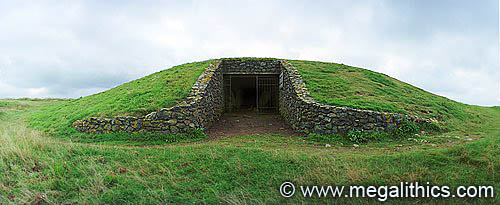
 |
|
More Pics |
|
|
Panoramas |
|
|
|
Rock Art |
| SH 32899 70746 (GPS 60min) - Entranceway. | |
| Visited August 2001 | |
Barclodiad y Gawres "The Giantess's Apronful" is a type of monument known as a decorated Cruciform Passage Grave, and its location here in Anglesey makes it very unusual. Tombs of this type are usually only found in Ireland and reach their zenith in the tombs of the Boyne valley area. Other surviving Cruciform Passage Graves exist in the rest of the British Isles, but they lack the characteristic decoration found in Barclodiad y Gawres and the Irish tombs. There may have been a similar tomb at Calderstones near Liverpool, stones recovered from this site do bear "Irish style" rock art , but the Calderstones monument has been completely destroyed and its designation as a passage grave is uncertain.
Barclodiad y Gawres has been sorely used by time, most of its structure being removed during its use as a stone quarry in the 18th century. Full excavation and documenting was carried out in 1952-3 by Powell and Daniel (1) and finally the wonderful rock art that the tomb contained was revealed.
Today the surviving stones of the chamber and passage are protected by a modern concrete dome, but the original covering mound was composed of turves, contained by an edging of stones. This is type of mound construction is also found in the Irish tombs such as that at Fourknocks. The mound at Barclodiad y Gawres was about 20m in diameter and analysis of tree pollen found under its remnants suggest that the tomb was surrounded by thick woodland when it was constructed.
The original passage was about 7m long and ran SSE to the chamber, it was a lot lower and narrower than the modern entrance way. The chamber is about 6m in diameter and has a terminal chamber and two side chambers, producing a cruciform layout. The SW chamber had been closed with stone blocking and has an unusual annexe chamber attached to it. The smaller chambers were originally roofed with capstones, only that of the terminal chamber surviving today. The main chamber was too wide for capstone roofing and was probably of corbelled construction, another typical feature found in the Irish tombs.
The most exciting feature of Barclodiad y Gawres must be its rock art. Several of the chamber stones bear carvings of lozenges, zig zags and spirals, but what makes some of them exceptional is the way the carved shapes are manipulated and shaped with each other to form an overall integrated design. This type of large scale integration, and the elements of the decoration itself is also seen in the rock art of the great Boyne valley tombs of Newgrange, Knowth and Dowth.
The carvings here have been made by pecking small pits in the stone surface, probably with a pointed hardstone chisel. The markings on some of the stones are very faint and are difficult to make out in the gloom of the interior, some of them also seem to have a strange "surface colouration" effect that we have not seen on rock art before. Our rock art section has both low angle illumination and diffuse light photographs, so that both the carved peck marks and the "surface colour" effect can be seen in detail.
Accounts by Frances Lynch (2) mention five carved stones and a more recent work by Stan Beckensall (3) shows the locations of six, his additional carving being shown as located on the blocking stone of the SW side chamber. We found six carved stones during our visit, but could find nothing on the blocking stone indicated by Beckensall, our extra carving was found on the northern side slab of the NE side chamber. The carving was a chevron and lozenge motif of a style comparable to other carvings in the chamber, see our rock art section for photographs of this stone.
Excavation revealed that the monument had been used for funerary purposes, the cremated bones of two men were discovered resting on the old ground surface in the SW chamber, the other two chambers had been dug into in the past and the only finds there were tiny bone fragments in the corners. Amongst the bones in the SW chamber were found the remains of two polished bone pins, thought to be clothes fastenings, these pins are a common find amongst bone in the Irish Cruciform Passage Graves.
No burials were found in the central chamber area, instead this seems to have been the focus for ritual activity. A fire had been burned here for some time, and on top of its remains were the remnants of a strange "stew". The contents of this stew have been identified by residual bone fragments and it consisted of a mixture of wrasse, eel, frog, toad, grass snake, mouse, shrew and hare. The fire site was then buried under a layer of pebbles and limpet shells.
Although no direct dating evidence exists for Barclodiad y Gawres, some Irish cruciform Passage Graves have been carbon dated to 2500-2400 BC and it is likely that Barclodiad y Gawres was constructed around this time.
(1)
Powell T.G.E. & Daniel G.E., Barclodiad y Gawres: The Excavation of a Megalithic
Tomb in Anglesey, 1956, Oxford University Press.
(2) Lynch F., Prehistoric Anglesey, 1970,
Anglesey Antiquarian Society, p70-9.
(3) Beckensall S., British Prehistoric Rock
Art, 1999, Tempus Publishing, Gloucester, p132-4.